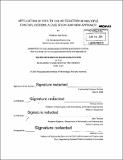| dc.contributor.advisor | Nancy Leveson and John Thomas. | en_US |
| dc.contributor.author | Placke, Matthew Seth | en_US |
| dc.contributor.other | Massachusetts Institute of Technology. Engineering Systems Division. | en_US |
| dc.date.accessioned | 2014-09-19T21:43:55Z | |
| dc.date.available | 2014-09-19T21:43:55Z | |
| dc.date.copyright | 2014 | en_US |
| dc.date.issued | 2014 | en_US |
| dc.identifier.uri | http://hdl.handle.net/1721.1/90170 | |
| dc.description | Thesis: S.M., Massachusetts Institute of Technology, Engineering Systems Division, 2014. | en_US |
| dc.description | Some pages printed landscape. Cataloged from PDF version of thesis. | en_US |
| dc.description | Includes bibliographical references (pages 113-114). | en_US |
| dc.description.abstract | A new approach for analyzing multiple control systems within the STPA framework has been developed and demonstrated. The new approach meets the growing need of system engineers to analyze integrated control systems, that may or may not have been developed in a coordinated manner, and assess them for safety and performance. This need comes from the increasing proliferation of embedded control systems across domains including defense, energy, healthcare, automotive, aerospace, and consumer products. When multiple embedded control systems are integrated together, they have the potential to operate in uncoordinated and conflicting ways which might hinder their performance and lead to unsafe behavior. This new approach provides a means for engineers to analyze the integration of control systems, beginning during concept development and continuing through the design process. The approach leverages the results of STPA Step 1 and guides the analyst in identifying instances of potential conflict between controllers. The method is demonstrated through a case study from the automotive domain, the integration of three driver assistance systems. The first application of the new approach identified instances of conflict amongst the three systems that would prohibit their successful operation in the field. Following the presentation of the case study, suggestions for future work and use in practice are provided. | en_US |
| dc.description.statementofresponsibility | by Matthew Seth Placke. | en_US |
| dc.format.extent | 147 pages | en_US |
| dc.language.iso | eng | en_US |
| dc.publisher | Massachusetts Institute of Technology | en_US |
| dc.rights | M.I.T. theses are protected by copyright. They may be viewed from this source for any purpose, but reproduction or distribution in any format is prohibited without written permission. See provided URL for inquiries about permission. | en_US |
| dc.rights.uri | http://dspace.mit.edu/handle/1721.1/7582 | en_US |
| dc.subject | Engineering Systems Division. | en_US |
| dc.title | Application of STPA to the integration of multiple control systems : a case study and new approach | en_US |
| dc.title.alternative | Application of Systems-Theoretic Process Analysis to the integration of multiple control systems : a case study and new approach | en_US |
| dc.type | Thesis | en_US |
| dc.description.degree | S.M. | en_US |
| dc.contributor.department | Massachusetts Institute of Technology. Engineering Systems Division | |
| dc.identifier.oclc | 890206314 | en_US |

